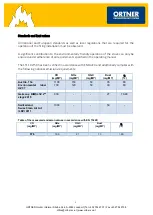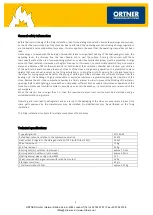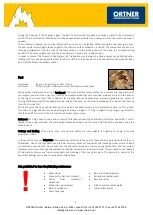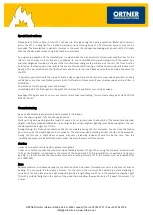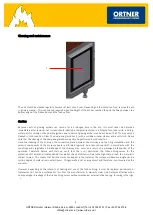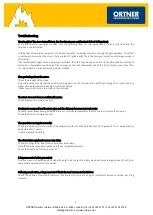
6
ORTNER GmbH | Hürmer Straße 36 in A-3382 Loosdorf | Tel +43 2754 2707 | Fax +43 2754 2708
[email protected] | www.ortner-cc.at
During the opening of the dual-pane glass, the door contact switch responds and sends a signal to the combustion
control. The control detects that the door has been opened and activates the air damper motor, the inlet air damper is
opened.
The combustion chamber can now be loaded with wood and can be ignited. When closing the dual-pane glass door,
the door contact switch again sends a signal to the control and the combustion is started. The combustion control runs
through a programme from the start of the combustion up to the cooling down of the stove, the so-called resting
position. The dual-pane glass door and the air damper are closed in the resting position.
In order to prevent the release of heating gas, the firebox door must always be closed except during lighting, when
refilling with fuel, and during ash removal. In order to refill fuel, the door may only be opened after the wood has been
burnt (shortly before the embers phase).
Fuel
Hardwood:
Beech, oak, ash, maple, birch, cherry
Softwood:
Willow, poplar, linden and almost all coniferous wood types
We generally recommend the use of hardwood. The most important precondition for a correct and long function of
your masonry heater is the use of dry, clean and untreated wood logs with a residual moisture content in the interior
of the log of no more than 20%. In addition to a greatly reduced heating value, wet wood generates an excess of
shining soot deposits (pitch-like deposit) on the inside of the pane, on the ceramic components as well as the chimney
(risk of a chimney fire).
Wood will only achieve an optimal heating value when it has been stored dry and ventilated under a roof for at least
two years. The logs should have an equal length and have a weight of 1-2 kg. In regard to the length, pay attention
that the wood fits correctly in the combustion chamber of your stove.
Softwood has a high calorific value and as a result of its reduced density by definition burns faster and hotter. For this
reason, when using softwood, the stack height should be halved and the second half should be inserted during the
embers phase.
Cuttings and kindling, of any type, even with optimal quality are only suitable for lighting or mixing in (overall
proportion < 10%).
In the event that you use briquettes, then please pay attention to the quality. These should be pressed without the use
of additives. Due to the high density and the low moisture content of briquettes, the stacking amount must be halved
and inserted a second time. Please note that the briquettes increase in volume during combustion. The fuel surface
increases many times over and the combustion chamber temperature increases sharply. This can cause an overheating
of the metallic fixtures and frame components and clouding of the inner glass pane. The warranty is voided in the
event that damage occurs due to the reasons stated above.
It is prohibited to burn the following substances:
Moist wood
Bark and chipboard waste
Wood with a high resin content
Painted and coated wood
Waste
from
carpenter’s
workshops
Bark briquettes
Woodchips, wood pellets
Kitchen and household waste
Plastics, cardboard
Combustible liquids
Coal of any type
!




